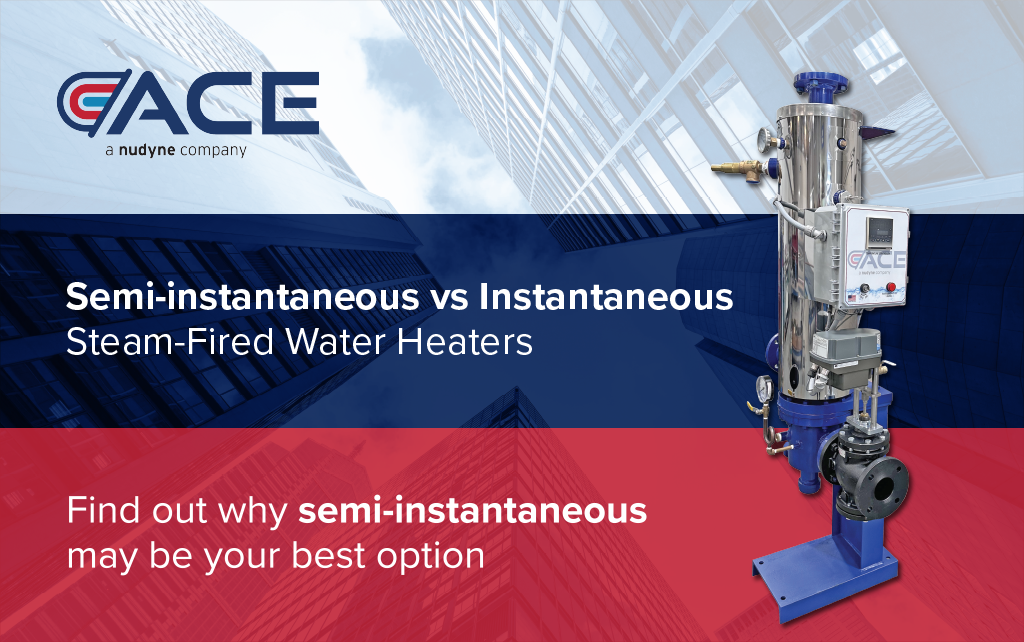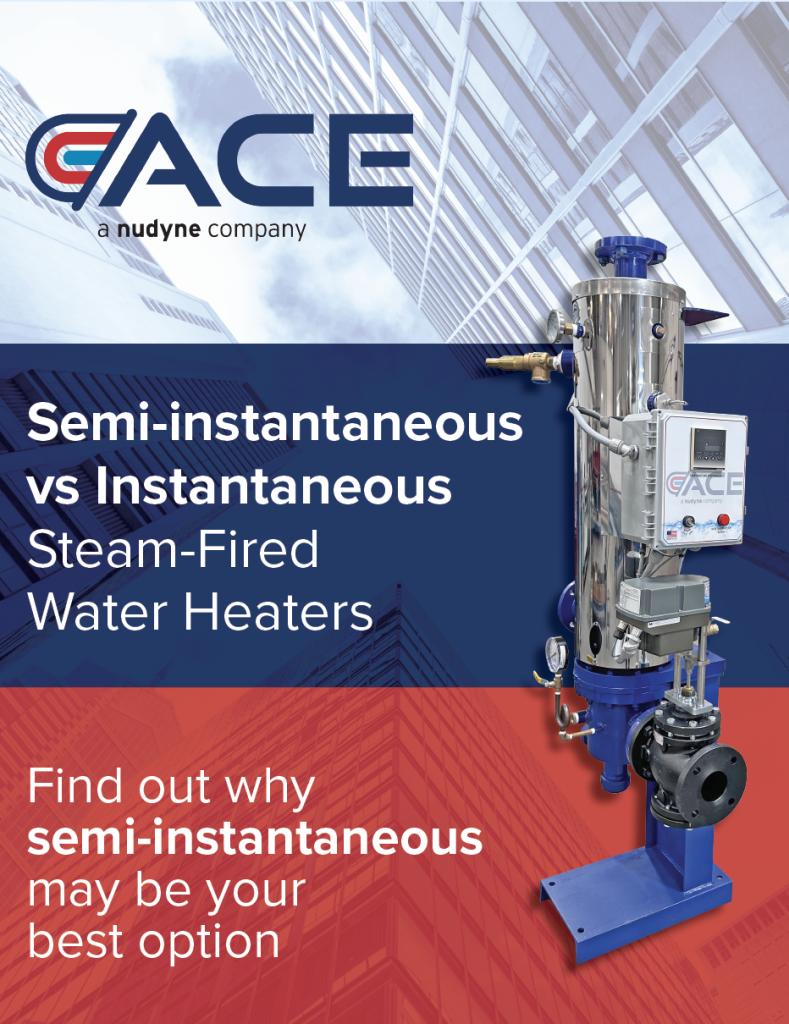Semi-Instantaneous vs Instantaneous Steam-Fired Water Heaters
Published: October 1, 2025
With the different styles and types of water heaters available, it raises the question of how each one works and what makes their unique characteristics advantageous for a specific application. Semi-instantaneous and instantaneous type water heaters heat indirectly using boiler water or steam to heat domestic hot water when it is called for (for the rest of this paper we will refer to the heating medium as steam).
Both types of water heaters are used to heat potable water in places such as hospitals, hotels, universities, office buildings, sports complexes, correctional institutions and other similar areas. Although instantaneous naturally sounds like the superior option due to the prefix “instant”, both instantaneous and semi-instantaneous are “on-demand” type exchangers with the ability to heat very large quantities of water instantly, without the need for large volumes of stored water.
When it comes to semi-instantaneous versus instantaneous water heaters, there are many distinctions between the two that need to be considered. Let’s discuss the differences of each further.
Semi-Instantaneous vs Instantaneous Water Heaters, Explained
According to the American Society of Heating and Refrigeration Engineers (ASHRAE) as well as the American Society of Plumbing Engineers (ASPE), these two water heater types can be differentiated as semi-instantaneous; those with steam in the tubes and water in the shell with 5:1 water to steam ratio, and instantaneous; heaters with steam in the shell and service water in the tubes, with a 5:1 steam to water ratio.
The latter results in a less efficient form of heat transfer, because the surrounding steam is being used to overheat the domestic water. There is a lack of control over the outgoing domestic water temperatures. The higher water-to-steam ratio of a semi-instantaneous water heater means the set point temperature is more controlled. The energy that is transferred heats the water within +/- 4°F of the desired temperature, resulting in more stable and efficient heat transfer of BTUs, virtually eliminating overheating.
Negative Effects of Imbalance
Excess heat doesn’t just produce more energy than is necessary, but also results in higher rates of scale (mineral) formation, causing build-up within the heater. In an instantaneous potable water heating system, large quantities of scale are more likely to occur due to the higher surface temperatures of the heat exchanger tubes. In an instantaneous potable water heating system, the water is being unnecessarily overheated to 250°F (if using saturated steam @ 15 PSI). Scale build-up slows down heat transfer and affects the overall performance of the unit.
Along with scale formation, thermal stress is directly related to the higher surface temperatures of the tubes. Higher thermal stress can lead to premature failures in the equipment, such as fractures. A semi-instantaneous unit sees lower surface temperatures, therefore reducing the possibility of such issues. The water to steam ratio imbalance with instantaneous type heaters, along with water traveling through the heat exchanger tubes in a short duration of time, makes controlling the outgoing water temperature difficult and creates the need for a temperature blending valve.
A blending valve (or thermostatic mixing valve) provides stable water temperatures and controls high water temps to prevent scalding to the end user and to meet strict code requirements. The downside is that installing the valve can be costly, as they need to be maintained and replaced in order for them to do their job effectively.
Using a semi-instantaneous hot water heater does not require a mixing valve because the imbalance is in favor of the domestic water, allowing for a more constant, efficient transfer of energy and lower temperatures. The higher volume of water in the shell allows the water to have more time to be heated to its exact temperature. The control system has time to react to temperature changes, preventing overheating.
Three Key Advantages of Semi-Instantaneous Water Heaters
So, what makes the Mini Pack semi-instantaneous water heater different than other heaters out there? The advantages are endless. The Ace Series MiniPack offers all critical design features, including sub-cooled condensate for improved efficiency, .049″ seamless copper heat exchanger tube walls for longevity, double solenoid over-temperature safety system (optional), high-grade construction, and customization. The sub-cooling condensate design offers several benefits, including:
- Increased efficiency: Sub-cooling can increase efficiency by as much as 25%, resulting in less steam required to meet the same GPM.
- No steam trap required. The condensate leaves the Mini Pack at lower temperatures, so the condensate will not flash back to steam
- No steam trap equals no potential for steam trap failure
- Heat that is typically lost to flash with an instantaneous type, heats the domestic water instead of being lost in the condensate receiver or flash tank.
- The life of the pump is extended due to cooler condensate being pumped out.
In addition to the condensing design of the Mini Pack, the thicker heat exchanger tube walls increase longevity and provide improved efficiency. Thin wall tube bundles may cost less but can result in premature failure and high replacement costs. In contrast, .049″ tubing can last up to 25-30 years. The double-solenoid high temperature system improves safety to protect against scalding. Using a predetermined high temperature setpoint, the system provides info to the EMS before a dangerous condition develops or the domestic hot water loop cools down. Then the system discharges at a lower temperature before the relief valve discharges at 210°F.
These features come wrapped in an unlined 316L stainless steel shell, different than other leading manufacturers that use a carbon steel shell with a thin copper lining on the water side. Liners are problematic because they can separate or split, exposing domestic water to carbon steel. This can result in rusty, discolored, and contaminated water, where unlined shells are trouble-free.
Ace offers many options to customize a Mini Pack in order to meet your requirements. Some of these options include:
- Double wall heat exchangers
- Copper, stainless steel, or CuNi tubing
- Vertical or horizontal (with optional single or dual rack) orientation
- Pilot, pneumatic, or electric controls
To Conclude
Comparing the two, the benefits of a semi-instantaneous water heater are clear. The thermal energy that is created with a semi-instantaneous water heater is more streamlined and purposeful, while working with instantaneous heaters will likely lead to negative issues caused by overheating. Overall the semi-instantaneous water heater was designed to provide safety, longevity, better performance, and lower costs.

Download White Paper PDF Here >
